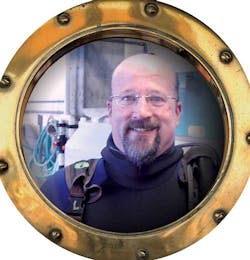Members of classes may participate in the Viking Explorers ROV Team. The remotely operated vehicles competition is sponsored by Marine Advanced Technology Education Center, in Monterey, Calif., and draws entries from colleges and universities worldwide. The 2007 Viking Explorers ROV team finished fifth overall and defeated all U.S. colleges and universities in the explorer division in the three-day competition. Fraser sat down recently with Automation World Editor In Chief Gary Mintchell to discuss the program.Automation World: Please describe your electrical program.Scott Fraser: The Department offers comprehensive general Electrical Certificate and Associate Degree Programs, in addition to specific courses to allow experienced electricians to upgrade their skills in specific areas. Robotics, or Industrial Automation, is a specialty area, which is an extension of the motor control and PLC (programmable logic controller) classes. Students are trained to set up and program industrial robots. Students are involved in the mechanical set-up as well as programming the robots to perform various tasks. The students set up and repair the robots in addition to programming them to perform tasks assigned by the instructor. Multiple work cells with conveyors allow students working on one robot to interact with the projects of students on other robots.The 45-unit program covers typical ac/dc electrical theory and also covers: Motors and Transformers, Motor Control, PLC Programming, Variable Speed Drives, Blueprints, Power Distribution, Commercial/Industrial Wiring Design, Robotics Technology, and Network Installation and Design.AW: Why incorporate computer aided design (CAD) into an electrical program?Fraser: Because industry is utilizing CAD in various levels, and students need to be prepared for the workplace. In the Robotics class, CAD was brought in initially to help the students design application specific parts required to complete a system. The Robotics class incorporates electrical, mechanical, electromechanical (pneumatics, hydraulics), vision systems and system programming. Incorporating CAD provides a way to develop components, subassemblies and assemblies that work the first time in an existing system. We have students using the CAD programs (AutoCad and Solidworks) within a week or two. At that point, they may be thought of as “CAD jockeys.” Once they incorporate all the items that are covered in our program, they cannot be considered CAD jockeys any longer. Designs are done incorporating requirements from state and national agencies. We stress industry standards. They are doing their own independent designs, as opposed to taking an engineer’s scribbles, cleaning them up and putting that into CAD. We had a company tell us that they would no longer recruit from drafting programs. They need those doing the work to understand the designs and what is going into the CAD drawings so that they can be given a rough framework and then be expected to fill in all the required or missing items.AW: How well are your students accepted in industry and what kinds of positions do they get?Fraser: We constantly have employers calling asking for our students. Many of them come back at the end of each year and actively recruit our students. The best testimonies are those that like our students and want more. Some companies that have hired our students include BP, Coca-Cola, ConocoPhillips, Fluor and Toyota. Positions include facilities maintenance, electrical design, instrument technician and underwater robotics technicians.
About the Author
Gary Mintchell
Editor in Chief
Sign up for our eNewsletters
Get the latest news and updates

Leaders relevant to this article:
